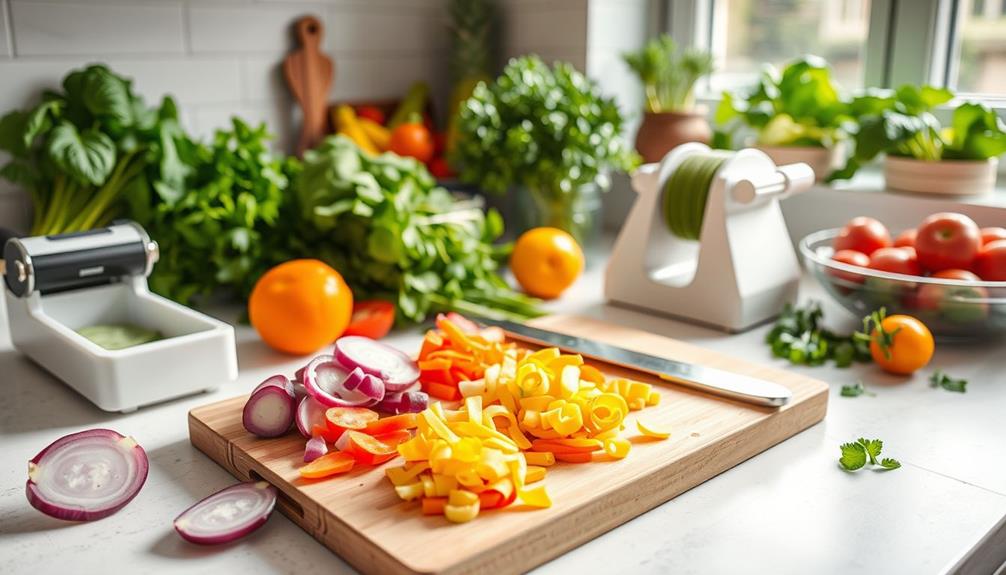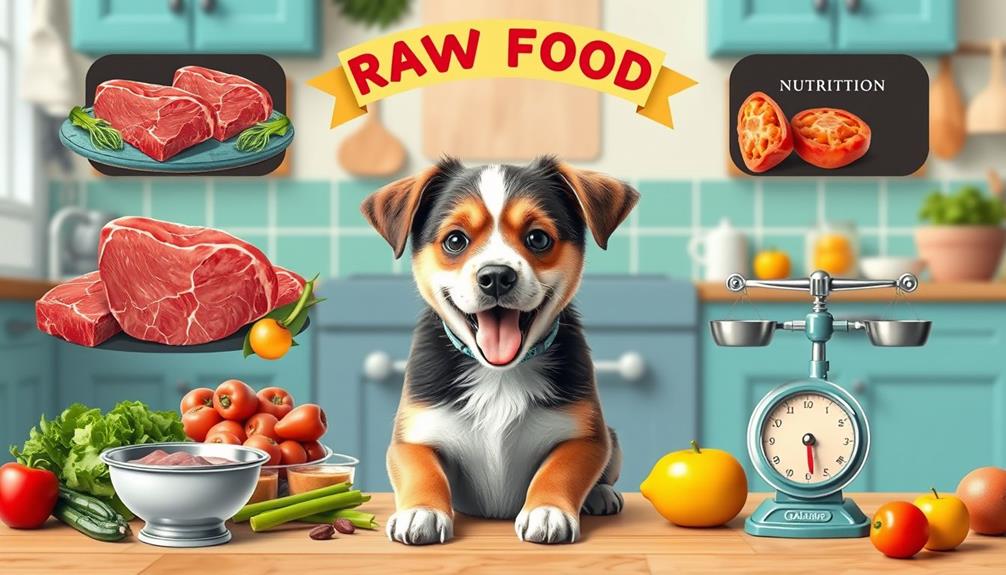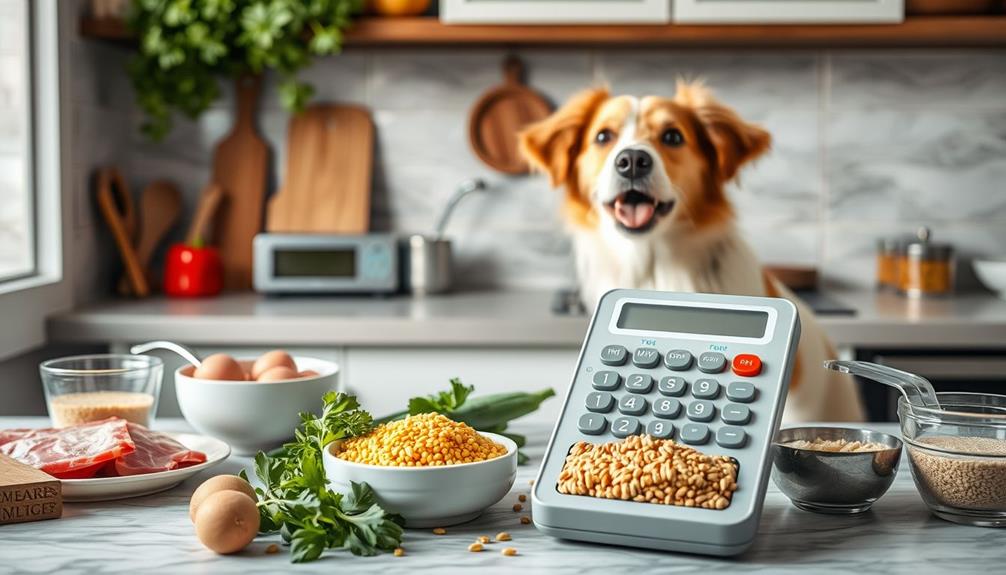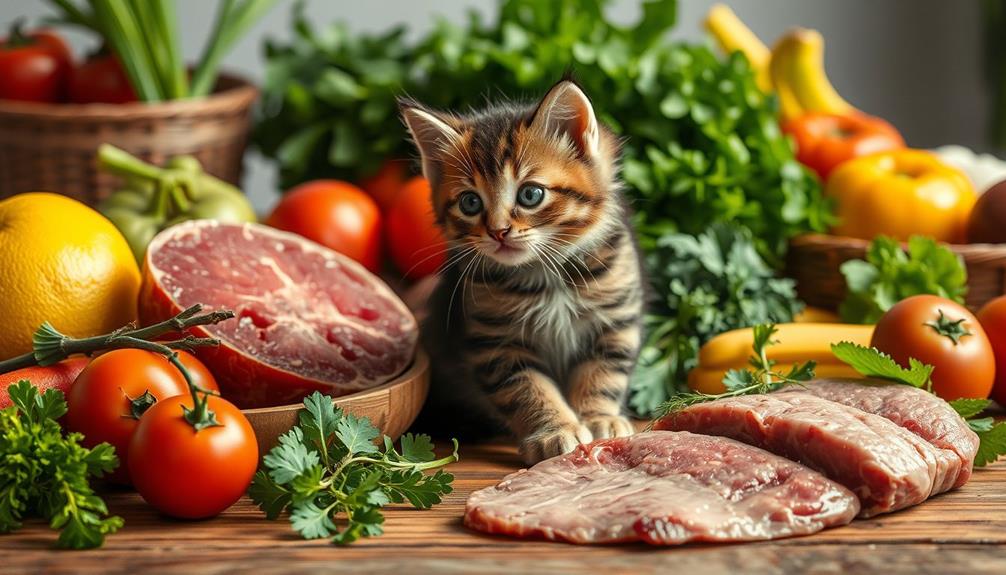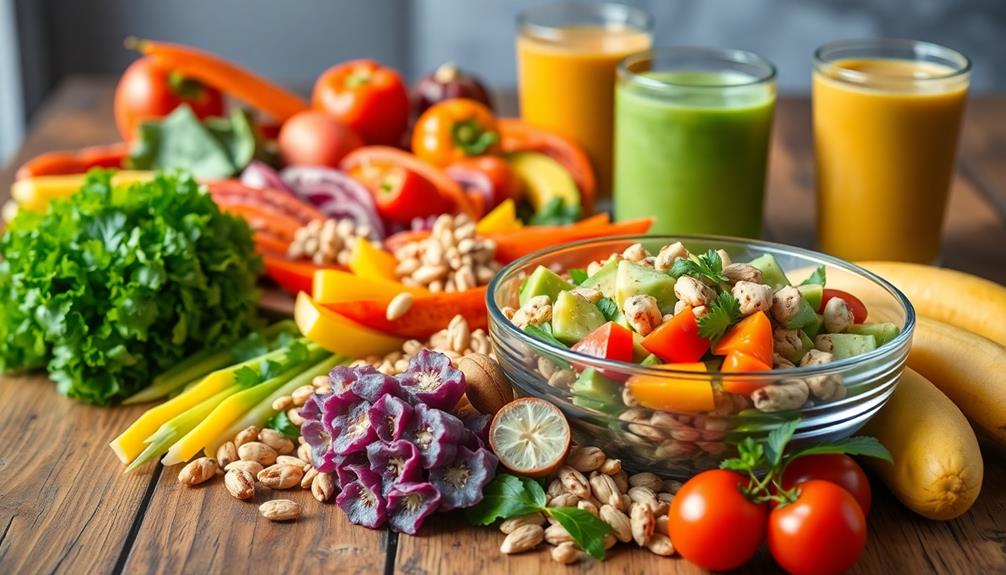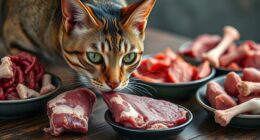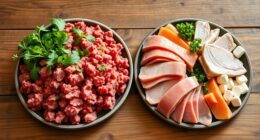When feeding your dog raw food, aim for 2% to 3% of their ideal body weight daily. For example, a 25 lbs dog needs about 0.5 lbs of raw food. Adjust this based on your dog's activity level; active dogs might need around 3%. It's best to split this into two meals to support digestion. Using a raw food calculator can help you find accurate portions tailored to your dog's specific needs. Regularly monitor their weight and energy levels to make necessary adjustments. Want to discover more tips on optimizing your dog's raw food diet?
Key Takeaways
- Use a raw food calculator by inputting your dog's weight to determine daily food portions accurately.
- Adult dogs generally require 2% to 3% of their ideal body weight in raw food each day.
- Active dogs may need up to 3% of their body weight due to higher energy requirements.
- Split daily portions into two meals to support healthy digestion and nutrient absorption.
- Regularly monitor your dog's weight and health to adjust food intake as necessary.
Understanding Raw Food Benefits
When it comes to your dog's health, a raw food diet offers a range of impressive benefits. One of the most noticeable changes you might observe is shinier coats and healthier skin. This improvement stems from better nutrient absorption that a raw diet provides. Since dogs often have reduced allergens and food sensitivities on this type of diet, their overall health can greatly improve.
Additionally, incorporating raw foods rich in antioxidants can support your dog's immune system and overall wellness, similar to how Cranberry Juice can benefit human health.
Moreover, the natural chewing required by raw food helps maintain good dental health. You'll find that it reduces plaque and tartar buildup, contributing to fresher breath and healthier gums.
When it comes to nutrition, high-quality raw meals are free from antibiotics and preservatives, ensuring that your dog gets balanced nutrition for peak health.
You'll also notice an increase in your dog's energy levels. A raw diet can enhance their overall wellness, making them more active and playful. This means more fun for you both!
Daily Portion Guidelines
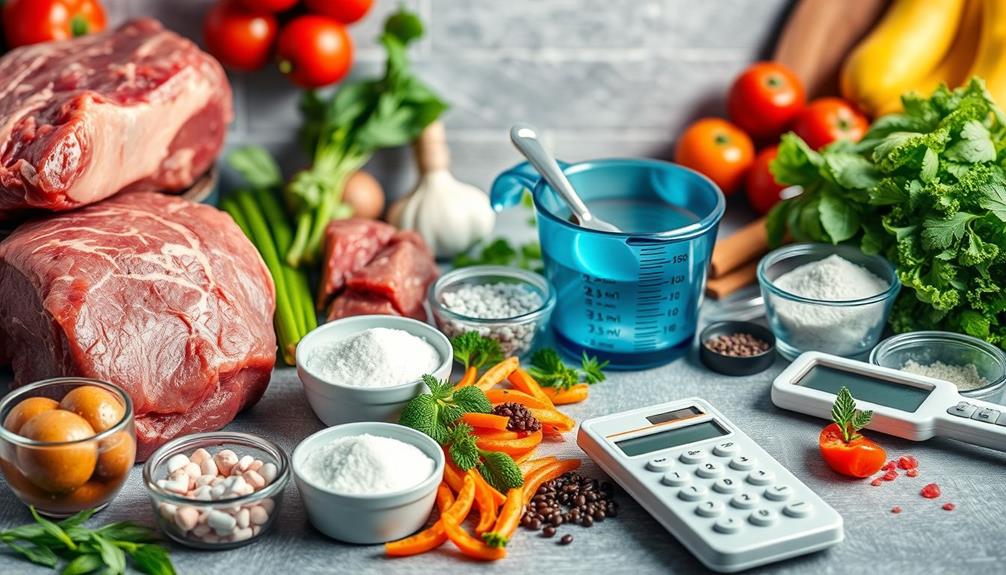
To guarantee your dog thrives on a raw food diet, it is crucial to follow proper daily portion guidelines. Adult dogs typically require 2% to 3% of their ideal body weight in raw food daily. However, this amount of food needed can vary based on your dog's activity level and health. For instance, a 25 lbs dog needs about 0.5 lbs (8 oz) of raw food each day, calculated as follows:
| Dog's Weight (lbs) | Percentage Needed | Daily Food Amount (lbs) |
|---|---|---|
| 10 | 2% | 0.2 |
| 25 | 2% | 0.5 |
| 50 | 2% | 1.0 |
| 75 | 2% | 1.5 |
| 100 | 2% | 2.0 |
Smaller breeds may require a higher percentage of their body weight, while larger breeds generally need less for maintenance. Remember to split daily portions into two meals, ideally in the morning and evening, to support healthy digestion during raw feeding. This approach helps confirm your dog gets the right food per weight while maintaining peak health.
Using the Raw Food Calculator
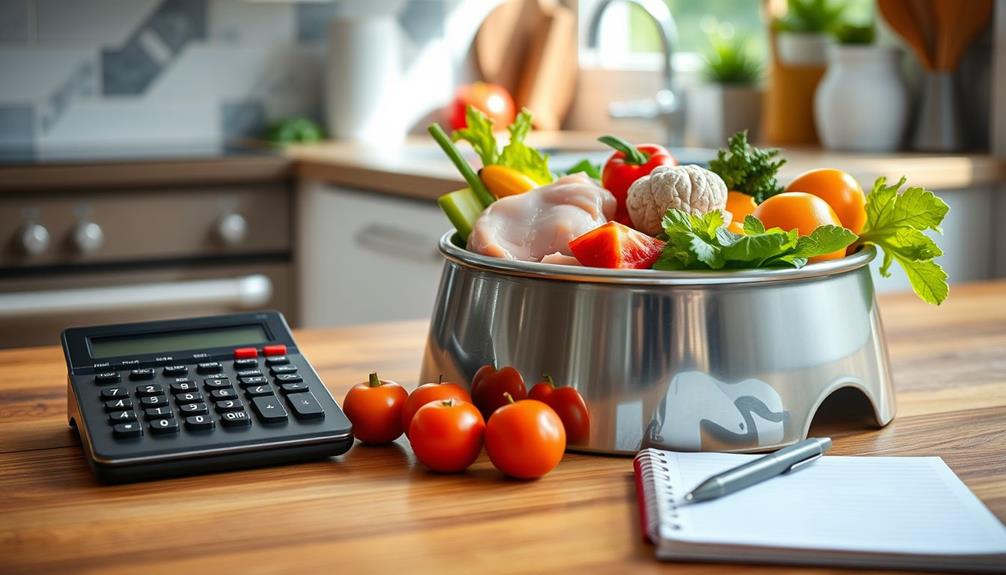
Determining the right portion of raw food for your dog can be simplified with the help of a Raw Food Calculator. This tool allows you to input your dog's weight and select the percentage of their diet that should consist of raw food, typically ranging from 10% to 100%.
For adult dogs, the calculator generally recommends feeding 2-3% of their ideal body weight daily. Additionally, understanding the nutritional needs of your dog can enhance their overall well-being, similar to how financial considerations for elderly care are essential for guaranteeing a comfortable life.
Here's how you can make the most of the Raw Dog Food Calculator:
- Input your dog's weight: This guarantees you're calculating the correct amount of raw food per day.
- Select the raw food percentage: Choose a percentage that matches your dog's dietary needs.
- Receive your calculations: Get your results via email in PDF format for easy reference.
Using the Raw Food Calculator not only helps you determine the right amount of raw food for your adult dogs but also assists in shifting from dry to raw diets.
Monitoring Your Dog's Health
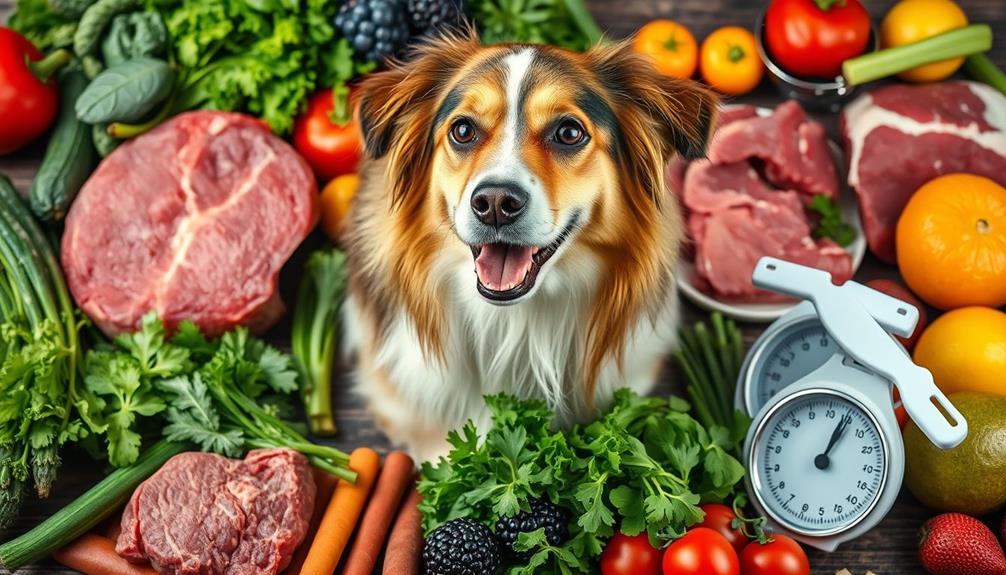
To keep your dog healthy on a raw food diet, regularly check their weight and adjust portions as needed.
It's important to guarantee that the food you provide is balanced and nutritious, similar to how hamster care emphasizes a proper diet with fresh ingredients proper diet guidelines.
Pay attention to their energy levels; active dogs might need more food while less active ones may require less.
Regular Weight Checks
Regular weight checks play an important role in guaranteeing your dog's health and well-being, especially since fluctuations in weight can signal underlying health issues or changes in dietary requirements.
Monitoring your dog's weight helps you maintain their ideal body weight, which is essential for their overall health. Additionally, just as with humans, maintaining a balanced diet is critical for your dog's health, so contemplate incorporating tips from a gout nutrition guide to verify their meals are nutritious and appropriate.
Here are some key points to reflect on during your weight checks:
- Observe Body Condition: Closely monitor your dog's body condition score; it helps determine if food intake adjustments are needed.
- Activity Level Matters: Active dogs might need increased portions, while less active dogs may require reduced portions to sustain ideal weight.
- Healthy Weight Loss: If your dog needs to lose weight, aim for a gradual loss of 1-2% per week to avoid undue stress.
Utilizing a feeding calculator can also assist you in determining the appropriate food intake based on your dog's weight and activity level.
Regular weight checks guarantee that your dog remains healthy and happy, allowing you to make informed decisions about their diet and lifestyle.
Adjusting Food Portions
Monitoring your dog's health goes hand-in-hand with adjusting their food portions. Regularly check your dog's weight and overall condition to guarantee they're getting the right amount of food tailored to their individual needs. If you notice any changes, it's time to adjust food portions accordingly.
Active dogs typically require more food, while less active dogs need reduced portions to maintain a healthy weight. Incorporating healthy dog snacks can also enhance their diet and keep them satisfied throughout the day.
During the initial shift to a raw diet, keep a close eye on your dog's weight. Temporary weight loss can occur as they adjust to the new food. Aim for a weight loss rate of no more than 1-2% per week if your dog is overweight, and don't hesitate to consult with your veterinarian for personalized advice.
Using a raw food calculator can help you determine specific feeding amounts based on your dog's unique requirements. As you monitor their response to the diet and any changes in body composition, you may need to revisit and adjust portions. To determine how much raw food to feed your dog, take into account their age, weight, activity level, and any underlying health conditions. It’s important to consult with a veterinarian or canine nutritionist to ensure that your dog is receiving the proper nutrients and balance in their diet. By using a raw food calculator and regularly evaluating your dog’s progress, you can make informed decisions on how much raw food to provide for optimal health and wellness.
Observing Activity Levels
Activity levels play an essential role in determining how much raw food your dog should eat. By closely monitoring your dog's activity, you can make informed adjustments to their food intake. Active dogs generally need more food, around 3% of their body weight, while less active dogs typically do well with about 2%. Understanding your dog's credit score can also help gauge their overall health and feeding needs.
To effectively observe your dog's activity levels, consider these key points:
- Track changes in body weight and overall health, especially during the shift to a raw diet.
- Maintain a consistent feeding routine by splitting daily portions into two meals, allowing you to assess energy fluctuations.
- Consult with an integrative veterinarian to tailor the diet based on your dog's specific needs.
Noticing initial weight loss may indicate water weight rather than fat loss, so keep an eye on your dog's progress.
Adjusting their food intake according to activity levels guarantees they maintain a healthy weight and peak health. By staying vigilant and proactive, you'll help your dog thrive on their raw diet!
Breed-Specific Feeding Recommendations
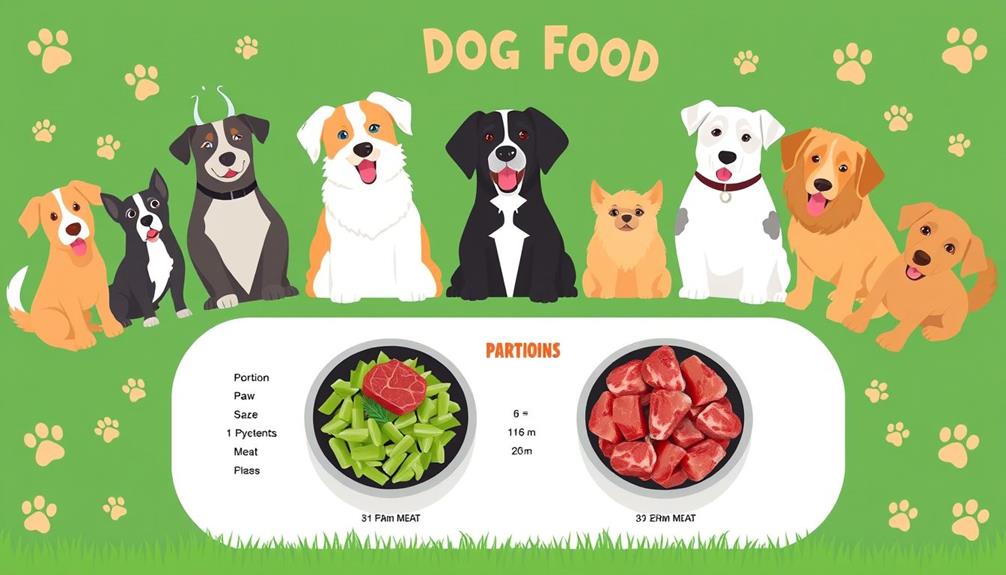
When it comes to feeding your dog, understanding breed-specific requirements is essential for their health and well-being. Different breeds have unique food needs that can greatly impact their overall health.
For instance, larger breeds like the Alaskan Malamute typically require a hefty daily intake of 680g to 900g of raw food, costing around £2.92 to £3.87. In contrast, smaller breeds like the Affenhuahua need only 40g to 100g, at a cost of £0.17 to £0.43.
Additionally, it's important to take into account that some essential oils, such as peppermint oil, can help with various health issues in pets, including nausea that may arise from dietary changes.
For dogs like the Afador and Afghan Hound, you'll find their daily food amounts range from 460g to 680g and 460g to 540g, respectively, with costs between £1.98 to £2.92 and £1.98 to £2.32.
The American Bulldog falls somewhere in between, consuming 540g to 1080g daily, costing £2.32 to £4.64.
Tips for a Successful Transition
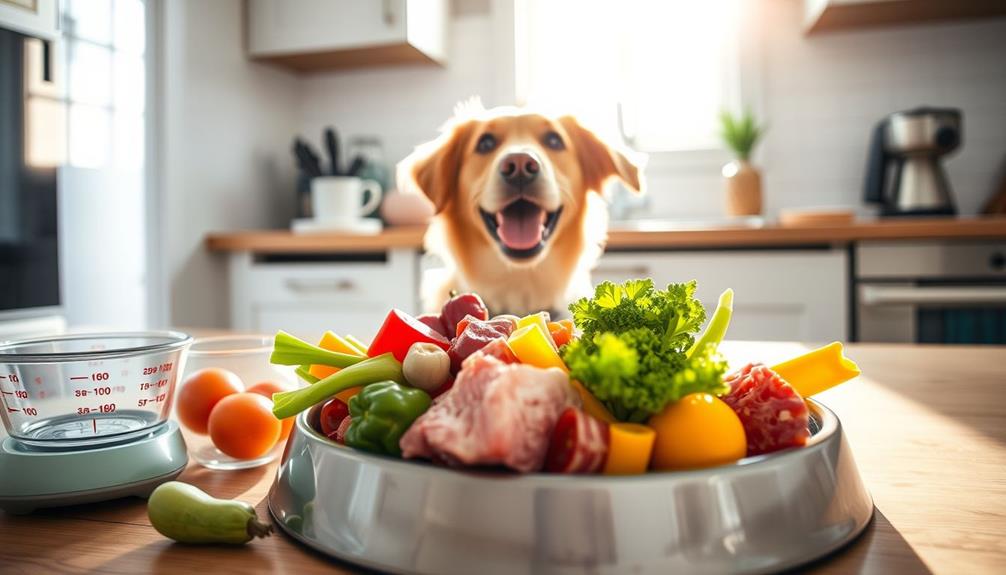
After identifying the specific feeding needs for your dog's breed, you might be enthusiastic to start them on a raw food diet. A raw food diet can provide dogs with natural enzymes that aid digestion and promote healthier skin and coat through the natural oils in raw foods raw food benefits.
However, a successful shift requires careful planning. Begin by gradually introducing raw food by mixing it with their current diet—start with 25% raw and 75% old food. Over 7-10 days, slowly increase the raw portion while monitoring your dog's weight and stool consistency closely.
Here are some tips to guarantee a smooth shift:
- Monitor changes: Keep an eye on your dog's weight and any digestive changes, as these can indicate if you need to adjust the diet.
- Adjust portions: Tailor the portion sizes based on your dog's activity level and age to guarantee they receive the right nutrition.
- Consult a vet: If you notice any adverse reactions or have concerns about specific dietary needs, consult with an integrative veterinarian.
Frequently Asked Questions
How Do I Calculate How Much Raw Food My Dog Needs?
To calculate your dog's raw food needs, determine their ideal body weight and multiply by 2% to 3%. Adjust based on activity level, and monitor their health for necessary portion changes.
How Much Raw Food Should I Feed My Dog Chart?
Did you know that active dogs might need 3% of their body weight in food daily? To determine how much raw food to feed your dog, refer to a chart tailored to their specific needs.
What Is the 80 10 10 Rule for Raw Dog Food?
The 80/10/10 rule for raw dog food means you should feed your dog 80% muscle meat, 10% edible bone, and 10% organ meat. This balance guarantees your dog gets essential nutrients for ideal health.
What Is the Best Raw Food Ratio for Dogs?
Imagine your energetic Labrador, Max, thriving on a balanced diet. For him, the best raw food ratio is 70-80% muscle meat, 10% bone, and 5-7% organs, ensuring he stays healthy and active.
Conclusion
Shifting your dog to a raw food diet can feel like opening a new chapter in their health journey. By understanding the benefits, using the calculator, and tailoring portions to your pup's needs, you're setting the stage for a vibrant life. Keep an eye on their health, and remember, each wag of their tail is a sign of your success. Embrace this adventure together, and watch your furry friend thrive like never before!


